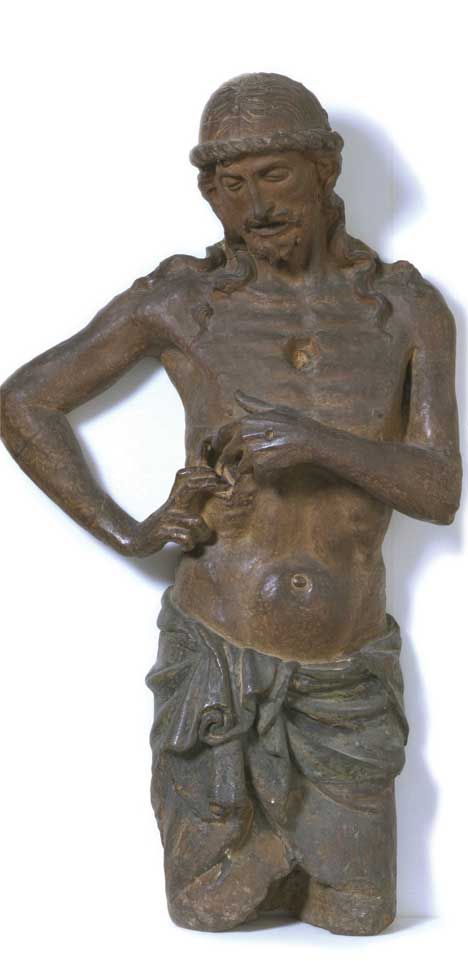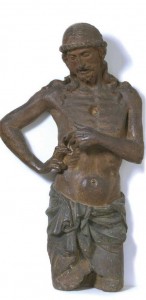How the Museum dealt with the dying of Christianity

The redisplay of the museum’s Medieval and Renaissance Galleries
By Anna Somers Cocks

A repugnant gesture or an allusion to the nature of faith? This 15th-century terracotta of Christ draws attention to the wound, reminding the viewer of Doubting Thomas who would not believe in the resurrected Christ until he had touched his wound
In the Middle Ages it rained a lot, the beastly barons kept throwing the peasants into dungeons and there was very little for the poor to eat except potatoes. This gallimaufry of Robin Hood meets Blackadder meets Marx on feudalism came from art college students in a survey conducted by the Victoria & Albert Museum in preparation to redisplaying its 3,250 square metres of Medieval and Renaissance Galleries. The galleries opened on 2 December.
The survey also showed that most people did not think much of medieval art: flat, ugly and “my children can draw better than this” was the most common reaction. The Renaissance elicited a more favourable, if fairly unsophisticated, reaction. It was seen as being sunny and optimistic; Florence figured largely, and most people could give the names of a few artists.
But the real wastelands of ignorance were revealed when it came to the stories, theology and liturgy of Christianity, and since 80% of these collections are religious in one way or another, the V&A realised that it had a challenge ahead if it wanted the art to be understood and appreciated.
This situation is unprecedented in western civilisation: even 50 years ago, when these galleries of one of the richest collections in the world were last displayed in the V&A, they could assume that everyone was familiar with the rudiments of Christianity. Now, in a twinkling of an eye, 2,000 years of culture in the profoundest meaning of the word have been largely forgotten. There has been a slump in the practice of religion in all western countries except the US, and therefore of its transmission, in the family and in schools. This is true even in Catholic Italy, where, according to the Eurispes statistics office, in 2006, 87.6% of the population said it was Catholic, but only 36.6% was practising. The one hour a week of religious study at school has been optional since 1984, and in any case focuses on the catechism, so the gospel stories are almost unknown. Gianni Romano, professor of history of art at Turin University, says his pupils will recognise the Annunciation and perhaps St Peter with his keys, but not the less popular St Paul with his sword, while any of the less famous episodes, such as Doubting Thomas, will be quite unknown to them.
In the UK, the decline is even more marked. According to research conducted in 2005 by the Christian Research English Church Census, only 6.3% of the population go to church on Sunday. In the Mori poll of 2003, only 56% of the population could name one of the Christian gospels (Matthew, Mark, Luke, John).
Paradoxically, for decades after a 1944 law, religion was the only subject that UK schools were obliged to teach, but in the secularising, revolutionary 1960s and 1970s this was widely ignored in state schools. Now it has had a revival in the guise of multiculturalism and citizenship classes because society has become more diverse, with 2.7% of the population Muslim and 1% Hindu.
The emphasis today is very much on bridging the gaps between communities, say Matthew Burrows, a teacher of religion in a Church of England school. Even here though, there is no continuous narrative of the Old and New Testaments and no theological structure. “We tend to examine themes common to all religions, such as ‘Love your neighbour’, or the major feasts of other religions, such as Eid al-Fitr [the con clusion of Ramadan]”, he says.
Admirable as this is, it leaves little time or inclination to get to know the sequences and routines of Christianity, so no Virtues and Vices, no Stations of the Cross, no liturgical seasons or colours, not even a mention of the programmes of prayer, such as the Rosary or the Offices of the Day.
The complex system of type and antitype, whereby the key episodes in the New Testament are considered to have been prefigured by events in the Old Testament, is not taught, partly because it might offend the Jews. Cultural sensitivities even lead to the sacrificial aspects of the Crucifixion being downplayed, as being too alien and negative in our society. The result is that pupils leave school not only without many of the facts of Christianity, but much of its way of thinking.
Whether you are happy with this or not, it presents historians of pre-19th-century art everywhere with a major problem. They are no longer part of a mainstream, but students of the arcane. The V&A’s reaction was first to find out what different communities did and did not know. It conducted separate focus groups with six people each from secular, Catholic, Anglican, UK-born Muslim and non-UK-born Muslim communities. All were shown a chalice, a cope embroidered with the Crucifixion, a Virgin and Child, a statue of St Roch with the dog licking his bubos, a booklet painted with symbols of the Crucifixion, and reactions were noted (perhaps not surprisingly, the last two were of the greatest interest to everyone). Later on, there was a second round of focus groups, where exhibits and their labels (never more than 50 words long) were projected and the texts were redrafted if they were found to be too obscure; it emerged, for example, that the Muslims wanted more background on the Mass. The labels have all been read by one of the priests from the nearby Brompton Oratory, thus eliminating solecisms such as “performing the Mass” (“celebrating” is the right word). “But we didn’t want to conceive these galleries as a book, not least because you can’t guarantee that people will read all the labels”, says Glyn Davies, one of the curators involved. Each room has a narrative and date frame with a number of specialised areas, such as “Signs and Symbols”, “Personal Devotion” or “The Art of Dying”. The designers, the London firm MUMA, have worked hand in glove with the curators to make the most of every object, so although the discipline of material culture studies lies behind the mode of presentation, no one can say that the aesthetic quality of the works of art has been neglected. Great masterpieces, such as the Donatello Ascension, are given special treatment, so that the public will linger over them.
Much is communicated by context, so, for example, there is a procession, with the priests suggested by “floating” vestments, a crozier, processional cross and banner, all led by a Gothic sculpture of Christ on a donkey. Nearby, but so located as not to distract from the works, is a digital screen showing just such a sculpture still in use in a Palm Sunday procession in Thaur in Austria.
Throughout the galleries there are 16 of these discreetly located screens. Other particularly complex and interesting works, such as an Apocalypse altarpiece, have a seat in front of them, with a booklet that explains the work in greater detail, in this case inviting the viewer to notice how the painter drew on a Franciscan commentary and deviated from the Book of Revelation.
In no way do these galleries dumb down.
The depth of knowledge on which this presentation draws is very great. The curators are all scholars in their own right, but they have also consulted widely in the five years of preparation. Besides linking up with other medievalists and Renaissance scholars internationally to exchange ideas, they have entered other fields such as the history of science and of music. At their invitation, the nearby Royal College of Music has performed some of the music in the manuscripts and even engraved on a ceremonial carving knife, so that the notes have come to life after centuries of silence.
The difference between now and 50 years ago is that, having to make more of an effort to reach out to the public and with vastly greater expertise in doing so, the V&A will never again tolerate the intellectually lazy attitude that produced one label, written only 30 years ago, whose author thought “There are two similar pieces in a Berlin museum” was sufficient commentary on a work of art.
Cost of the galleries £30m
£9.75m from the Heritage Lottery Fund, the balance from private donors, including Paul and Jill Ruddock, the Garfield Weston Foundation, the Monument Trust, Simon Sainsbury, the Wolfson Foundation, Edwin and Susan Davies OBE, the American Friends of the V&A through Robert H. Smith, the Hintze Family Charitable Foundation, the Selz Foundation, the Bonita Trust, the Foyle Foundation and other private individuals and trusts.
Publications accompanying the galleries
Glyn Davies and Kirstin Kennedy Medieval and Renaissance Art: People and Possessions • Marian Campbell Medieval Jewellery in Europe 1100-1500 • Angus Patterson Fashion and Armour in Renaissance Europe • Eleanor Townsend Death and Art: Europe 1200-1530 • Jo Wheeler Renaissance Secrets: Recipes and Formulas • Paul Williamson and Peta Motture eds. Medieval & Renaissance Treasures from the V&A • (All V&A Publications, 2009)
| The Art Newspaper |


This Post Has 0 Comments